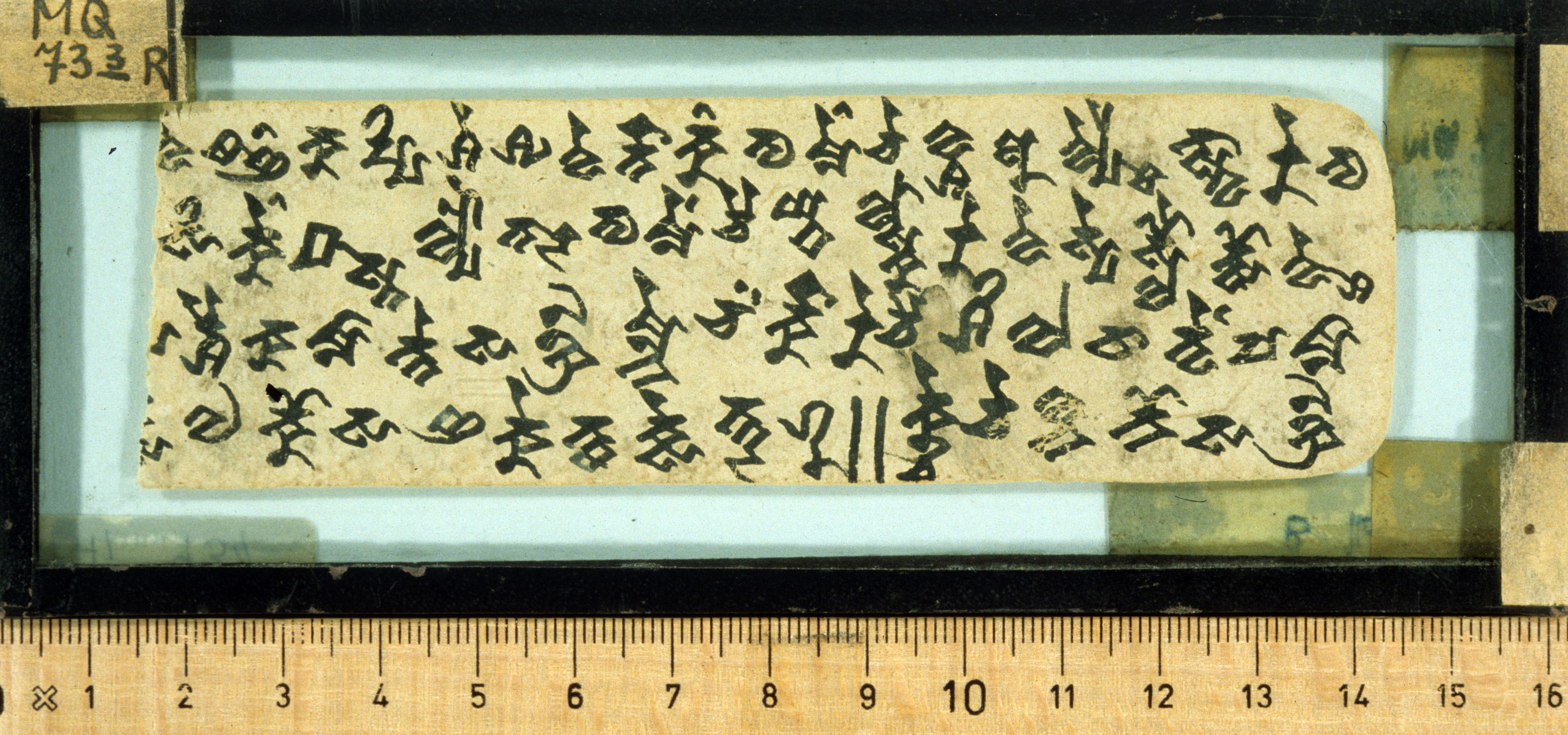THT 431
| Known as: | THT 431; B 431 |
|---|---|
| Cite this page as: | Adrian Musitz (translation). "THT 431". In A Comprehensive Edition of Tocharian Manuscripts (CEToM). Created and maintained by Melanie Malzahn, Martin Braun, Hannes A. Fellner, and Bernhard Koller. https://cetom.univie.ac.at/?m-tht431 (accessed 03 Jul. 2025). |
Edition | |
| Editor: | Adrian Musitz (translation) |
Provenience | |
| Main find spot: | Kizil Ming-öy |
| Expedition code: | T III MQ 73.3 |
| Collection: | Berlin Turfan Collection |
Language and Script | |
| Language: | TB |
| Linguistic stage: | classical |
| Script: | classical |
Text contents | |
| Title of the work: | History of Buddhist scholarship |
| Passage: | Dispute about the āvāsikas; praise of Śīlavanda |
| Text genre: | Literary |
| Text subgenre: | History |
| Verse/Prose: | prose; verse |
Object | |
| Material: | ink on paper |
| Form: | Poṭhī |
| Number of lines: | 4 |
Images
Images from idp.bbaw.de by courtesy of the International Dunhuang Project Berlin, the Berlin-Brandenburgische Akademie der Wissenschaften, and the Staatsbibliothek zu Berlin – Orientabteilung.
Transliteration
| a1 | /// ści ro na re kau na we ṣyeṃ śwā tsi ṣṣe i me mā ya ma ṣye ntra |
|---|---|
| a2 | /// [cai] ña ke ṣa mā ñe e re pa te sa tsa kse ntra 6 || kuce ce wne no sa |
| a3 | /// ma ne ma lwā ma ne kwa snā ma ne • ce yra no nau¯ ¯s̝ kā śyā¯ ¯m pa |
| a4 | /// yeṃ : pa kwā ri • a wā sī ki • ce n[a¯] [¯śä] ṣe śi la wa nde tsu wa : |
| b1 | /// we sa¯ ¯ñ ka ppi śe śu we rtā kaṃ tu meṃ ce wśa a lyai¯ ¯k tswā re tu |
| b2 | /// si keṃ pa¯ ¯st lyau ta¯ ¯r tu meṃ cai ypa lskā re we sye slau tso we¯ ¯ś |
| b3 | /// [pa] rśai ka mā nte sa ṅkrā mne cä rkā re cai śi la vā ndeṃ ṣa mā |
| b4 | /// ·s· o ko sa ña ke tsa kse ntra 7 || kuce ce wna no sa ṅkrā |
Transcription
| a1 | /// ścirona rekauna weṣyeṃ śwātsiṣṣe ime mā yamaṣyenträ |
|---|---|
| a2 | /// cai ñake ṣamāñe erepatesa tsäksenträ 6 ॥ kuce cewne no sa |
| a3 | /// mane mälwāmane kwasnāmane • cey rano nauṣ kāśyām pa |
| a4 | /// yeṃ : pakwāri • awāsīki • cenaś ṣe śilawande tsuwa : |
| b1 | /// wesäñ kappi śeśuwer tākaṃ tumeṃ cewśa alyaik tswāre tu |
| b2 | /// sikeṃ päst lyautar tumeṃ caiy pälskāre wes yes lautso weś |
| b3 | /// parśai kamānte saṅkrāmne cärkāre cai śilavāndeṃ ṣamā |
| b4 | /// ·s· okosa ñake tsäksenträ 7 ॥ kuce cew nano saṅkrā |
Translation
| a1 | ... they were speaking harsh words. They were not thinking about food. |
|---|---|
| a2 | ... they now burn in the form of a monks... |
| a2+ | What... in this... |
| a3 | ... lamenting, mourning... |
| a3+ | They also earlier... of the (Buddha) Kāśyapa... |
| a4 | ... they were evil āvāsika-monks. To those, only Śīlavanda attached himself... |
| b1 | ... our food will be something pure. Then, others attached themselves to him (Śilāvanda)... |
| b2 | ... they expelled the āvāsika-monks. Then they thought: "You have expelled us..." |
| b3 | ... they brought torches (?) and threw them into the monastery. |
| b3+ | They... Śilvānda-monks (?)... |
| b4 | ... as a fruit (thereof), they now burn. What now... the monastery... |
Other
| a1 | ... harte Worte sagten sie, die Erinnerung an Essen machten sie nicht. (Schmidt 1974: 338) |
|---|---|
| a4+ | Only Śīlavanda joined them. … «… our food will be proper!» Then others joined him … (Peyrot 2013b: 661) |
References
Online access
Edition
Sieg and Siegling 1953: 286-287
Translations
Carling 2000: b3 (156), b4 (236); Peyrot 2013b: a4 b1 (661); Schmidt 1974: a1 (338); Thomas 1954: a1 (760); Thomas 1957: a1 (49); Thomas 1986: b4 (129)
Bibliography
Carling, Gerd. 2000. Die Funktion der lokalen Kasus im Tocharischen. Berlin/New York: de Gruyter.
“The International Dunhuang Project: The Silk Road Online.” n.d. http://idp.bl.uk.
Peyrot, Michaël. 2013b. The Tocharian subjunctive. A study in syntax and verbal stem formation. Vol. 8. Brill’s Studies in Indo-European Languages & Linguistics. Leiden/Boston: Brill.
Schmidt, Klaus T. 1974. “Die Gebrauchsweisen des Mediums im Tocharischen.” PhD, Universität Göttingen.
Sieg, Emil, and Wilhelm Siegling. 1953. Tocharische Sprachreste. Sprache B, Heft 2. Fragmente Nr. 71-633. Edited by Werner Thomas. Göttingen: Vandenhoeck & Ruprecht.
Thomas, Werner. 1954. “Die Infinitive im Tocharischen.” In Asiatica. Festschrift Friedrich Weller. Zum 65. Geburtstag, gewidmet von seinen Freunden, Kollegen und Schülern, edited by Johannes Schubert and Ulrich Schneider, 701–64. Leipzig: Harrassowitz.
Thomas, Werner. 1957. Der Gebrauch der Vergangenheitstempora im Tocharischen. Wiesbaden: Harrassowitz.
Thomas, Werner. 1986. “Zur Stellung von toch. A nuṃ, B nano ‘wieder’ innerhalb des Satzes.” Zeitschrift für Vergleichende Sprachforschung 99: 117–46.
Gippert, Jost, Katharina Kupfer, Christiane Schaefer, and Tatsushi Tamai. n.d. “Thesaurus Indogermanischer Text- und Sprachmaterialien (TITUS): Tocharian Manuscripts from the Berlin Turfan Collection.” http://titus.fkidg1.uni-frankfurt.de/texte/tocharic/thtframe.htm.




